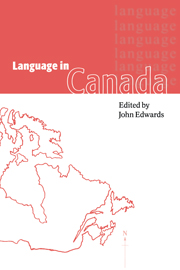Book contents
- Frontmatter
- Contents
- List of figures
- List of maps
- List of tables
- Notes on contributors
- 1 Canada
- Introduction
- 1 The foundations
- 2 The fading Canadian duality
- 3 Official bilingualism: from the 1960s to the 1990s
- 4 Official multiculturalism
- 5 Language in education: bridging educational policy and social psychological research
- 6 Aboriginal languages: history
- 7 Aboriginal languages: current status
- 8 French: Canadian varieties
- 9 French in Quebec
- 10 French in New Brunswick
- 11 French outside New Brunswick and Quebec
- 12 English: Canadian varieties
- 13 English Quebec
- 14 The teaching of international languages
- 15 French immersion in Canada
- 16 Language in Newfoundland
- 17 Language in Prince Edward Island
- 18 Language in Nova Scotia
- 19 Language in New Brunswick
- 20 Language in Quebec: aboriginal and heritage varieties
- 21 Language in Ontario
- 22 Language in Manitoba
- 23 Language in Saskatchewan: Anglo-hegemony maintained
- 24 Language in Alberta: unilingualism in practice
- 25 Language in British Columbia
- 26 Language in the Northwest Territories and the Yukon Territory
- Index of names
- Index of language families, languages, dialects
- Index of subjects
22 - Language in Manitoba
Published online by Cambridge University Press: 18 February 2010
- Frontmatter
- Contents
- List of figures
- List of maps
- List of tables
- Notes on contributors
- 1 Canada
- Introduction
- 1 The foundations
- 2 The fading Canadian duality
- 3 Official bilingualism: from the 1960s to the 1990s
- 4 Official multiculturalism
- 5 Language in education: bridging educational policy and social psychological research
- 6 Aboriginal languages: history
- 7 Aboriginal languages: current status
- 8 French: Canadian varieties
- 9 French in Quebec
- 10 French in New Brunswick
- 11 French outside New Brunswick and Quebec
- 12 English: Canadian varieties
- 13 English Quebec
- 14 The teaching of international languages
- 15 French immersion in Canada
- 16 Language in Newfoundland
- 17 Language in Prince Edward Island
- 18 Language in Nova Scotia
- 19 Language in New Brunswick
- 20 Language in Quebec: aboriginal and heritage varieties
- 21 Language in Ontario
- 22 Language in Manitoba
- 23 Language in Saskatchewan: Anglo-hegemony maintained
- 24 Language in Alberta: unilingualism in practice
- 25 Language in British Columbia
- 26 Language in the Northwest Territories and the Yukon Territory
- Index of names
- Index of language families, languages, dialects
- Index of subjects
Summary
Manitoba is unique in that it was the first province to join the confederation of Canada after 1867. In 1870, only three years later, Manitoba became the fifth keystone province, the gateway to the northwest. ‘Keystone’, because it comprised only a small territory around the heart of Fort Garry at the conjunction of the Red and Assiniboine rivers, which later expanded many times to its present size. It was the ‘gateway’ to the northwest, because fifteen years later, when the railway came to Winnipeg in 1885, it became the link for eastern entrepreneurs who warehoused their products at Fort Garry (Winnipeg, 1874), and distributed these manufactured goods westward to the prairies and beyond.
LANGUAGE POLICIES
For hundreds of years the aboriginals had the flat lowlands, where Winnipeg is now located, as a camping ground, using the Assiniboine river as a waterway from the west, and the Red river as a route from the south and the north. So it is not surprising that both the French Northwest Fur Trading Company, working out of Montreal from the east, and the British Hudson's Bay Company coming down from the north, began to build trading posts at the forks. Thus, Fort Garry also became the first natural meeting place of the aboriginals, the French and the British.
- Type
- Chapter
- Information
- Language in Canada , pp. 414 - 423Publisher: Cambridge University PressPrint publication year: 1998



